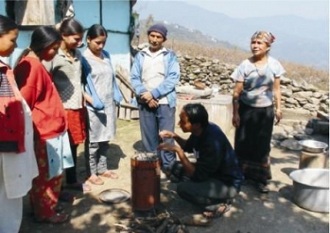Int J Agric & Biol Eng, 2011; 4(2): 64-73.
Evaluation of powered charcoal stove using different biomass fuels.
Alakali J S, Kachataiya G T, Kucha C T.
A powered stove was designed to utilize biomass effectively with easy ignition, uniform fire, and shorter cooking time. The stove consists of a blower with hand winder and a fuel carrier. Performance evaluation carried out show that boiling time decreased with increased volumetric air flow rate. For air flow rates of 0.13 m3/s, 0.14 m3/s, and 0.16 m3/s, the time to bring 4.5 L of water to boiling point decreased correspondingly from 14 to 12 and to 10 min. This trend was observed for all the biomass used namely wood, corn cobs and charcoal. However in comparing with the three biomass fuels, it took longer time to bring water to boiling point by using charcoal followed by wood and corn cobs in the above order. The percentage heat utilized and fuel efficiency increased with increase in the volumetric air flow rate. There was no significant difference (P≥0.05) in the heat utilization and fuel efficiency of wood, corn cobs and charcoal. The results also show that the specific fuel consumption decreased with air flow rate when yam, rice and beans were cooked. On the other hand, time spent for cooking the items increased significantly (P≤0.05). Also in comparison, the specific charcoal consumption for cooking yam, rice and beans was less followed by wood and corncobs. Moreover, the time spent for cooking the food items was longer by using charcoal followed by wood and corncobs. The results show that when powered the stove performed much better than under natural air flow condition and its efficiency increased with increase in volumetric air flow rate. Corncobs were found to be more suitable replacer of wood for domestic cooking followed by charcoal. The popularization of this stove will alleviate the problem of starting and maintaining fire and reduce over-dependence on wood.



